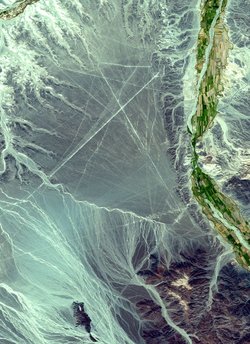Nazca Lines
|
|
The Nazca Lines are geoglyphs (drawings on the ground) located in the Nazca Desert, a high arid plateau that stretches 37 miles between the towns of Nazca and Palpa on the pampa (a large flat area of southern Peru). The drawings include a hummingbird, monkey, spider and lizard, to name only a few of the over 300 drawings. They were created during the Nazca culture in the area, between 200 BC and 600 AD.
The Lines were first spotted when commercial airlines began flying across the Peruvian desert in the 1920s. Passengers reported seeing ‘primitive landing strips’ on the ground below. The Lines were made by removing the iron-oxide coated pebbles which cover the surface of the desert. When the gravel is removed, they contrast with the light color underneath. In this way the lines were drawn as furrows of a lighter color. Off the Pampa, south of the Nasca Lines, archaeologists have now uncovered the lost city of the line-builders, Cahuachi. It was built nearly 2,000 years ago and mysteriously abandoned 500 years later.
Toribio Mejia Xespe, a Peruvian doctor and anthropologist was the first scientist, in 1927, to show interest in what he called "great Incan ceremonial artifacts".
Swiss writer Erich von Däniken suggested in his 1968 book, "Chariots of the Gods", that the lines were built by ancient astronauts as a landing field. But the soft clay soil and layer of brown and black rocks in the Nazca desert would seem an unsuitable site for a landing strip. Joe Nickell has reproduced one of the figures using technology available to the Nazca Indians of the time, and without aerial supervision.
It has been proposed by some (for example Jim Woodmann) that the Nazcan lines presuppose some form of manned flight (in order to see them) and that a hot air balloon was the only possible available technology. Woodmann actually made a hot air balloon from materials and using techniques that would have been available to people at the time in order to test this hypothesis. The balloon flew (after a fashion) demonstrating that this hypothesis was possible, but there is no hard evidence either way.
Residents of the local villages say the ancient Indians conducted rituals on these giant drawings to thank the gods, and to ensure that water would continue to flow from the Andes.
References
- Bauer, Susan Wise (2001). The Story of the World, Vol. 1. Peace Hill Press. ISBN 0971412901
External links
- Die Linien von Nazca und Frau Maria Reiche (http://homes.hallertau.net/~alexbeck/bilder/sudam/nazca/nazca.html)
- NASA Earth Observatory page (http://earthobservatory.nasa.gov/Newsroom/NewImages/images.php3?img_id=5103)
- "The Nazca Lines Revisited: Creation of a Full-Sized Duplicate" (http://www.onagocag.com/nazca.html) - Joe Nickell's account of his reproduction
- Skeptic's Dictionary (http://www.skepdic.com/nazca.html)
- Nazca Lines (http://agutie.homestead.com/files/Nazca_Lines.htm) by Antonio Gutierrez from "Geometry Step by Step from the Land of the Incas" (plays music)
- Nazca Lines (http://www.trekker.co.il/english/peru-nasca-lines.htm) site information
Parts of this article are from the NASA Earth Observatory; [1] (http://earthobservatory.nasa.gov/Newsroom/NewImages/images.php3?img_id=5103)da:Nazca-linjerne de:Nazca-Linien es:Líneas y geoglifos de Nazca y de Pampas de Jumana fr:Géoglyphes de Nazca ja:ナスカの地上絵

